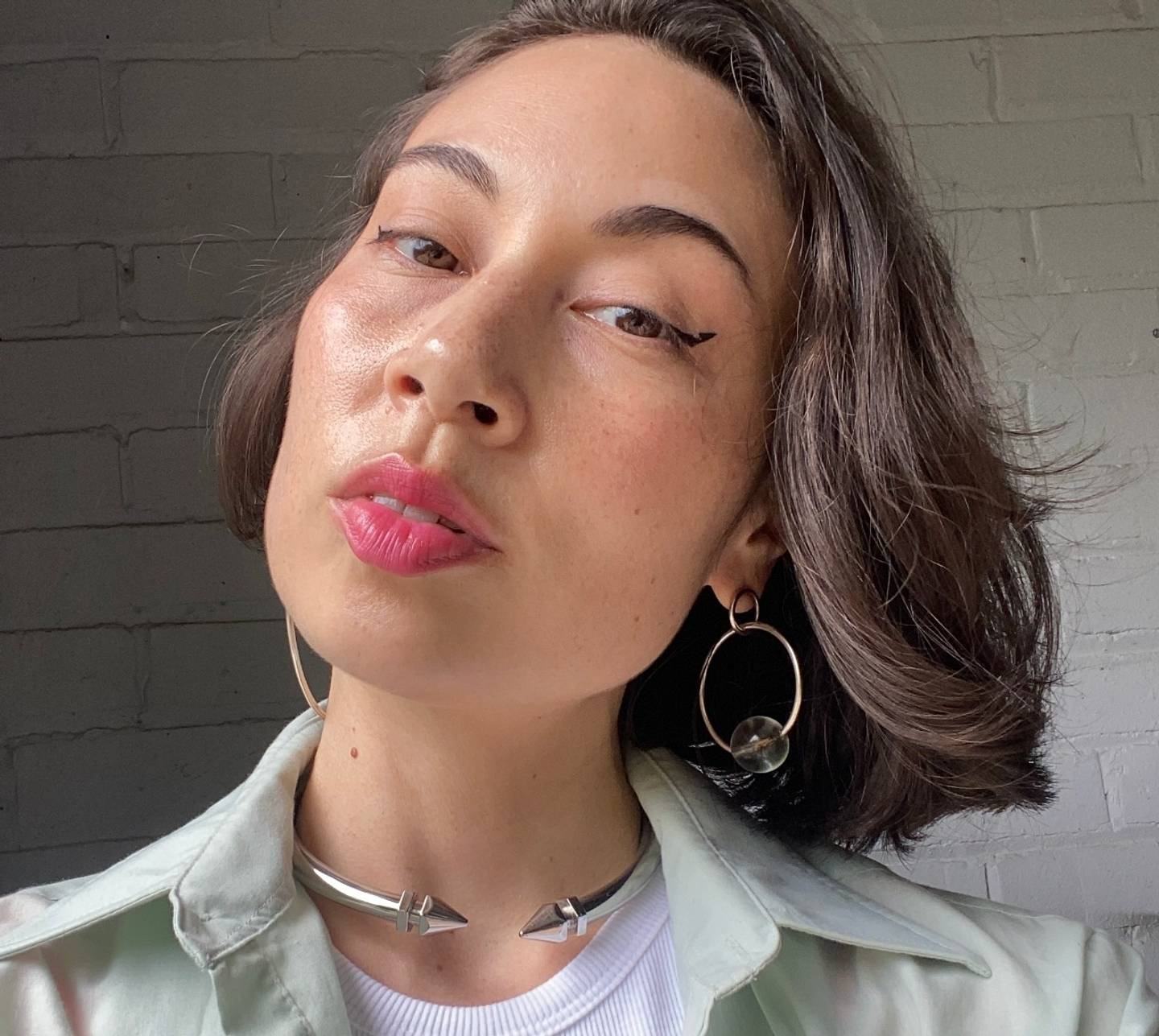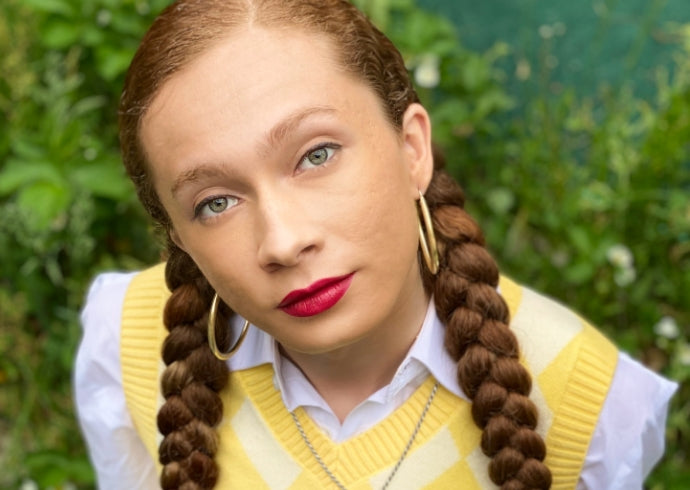At Milk, we stand for inclusivity and the freedom to live your life openly, authentically, and unapologetically. Laws that threaten our community affect all of us. A wave of recently passed and proposed anti-LGBTQIA+ legislation in the US is the latest attempt in an ongoing effort to strip the rights of LGBTQIA+ people. That’s why this Pride, we believe it’s more important than ever to uplift and create safe spaces for our community.
Throughout the month, our special guest editor Devin-Norelle, a model and trans advocate, is sharing the stories of seven people across the country who are actively fighting for their rights. Because all LGBTQIA+ people deserve to have a safe space to exist freely.
If an alternate universe of safe spaces existed, what might it look like? These are the portals to protection and infinite belonging that Chanel Matsunami Govreau creates through their installations, wearables, and self-portraiture. Her work is influenced both by her pansexual, genderfluid, queer identity, as well as their Japanese family history and folklore.
“I imagine how I can use these different resources to create connections to ancestors that I don’t know,” they say. “I think about queer ancestry: people who were never able to come out and live as their full selves. I also think about women without children and what ancestry meant to them when their lineage ended at a certain place—because I feel like that’s me. I try to create work in remembrance of folks that I don’t have access to or are lost to history.”
Chanel’s artwork is woven together with beings from folk tales: monsters called yōkai and many-eyed hyakume. But the spooky morphs into a safe, familiar feeling through her lens of ancestral remembrance. Through art, they also find a space to say things that are sometimes difficult to express through other forms of speaking.
“Something I recently discovered in my artist craft is that I’ve been using it for years as a place to safely explain my gender range,” they say. “Many people view me as this really femme person, but it came to a point where I completely rejected femmeness in my everyday life. When it came to my artist practice, I felt I could safely express myself as a femme person.”
Below, journey through Chanel’s realms of self-expression and safety.
What does a safe space mean to you?
A safe space is a place where you can feel at ease, rest, and experience a range of emotions without having to edit yourself or feel embarrassed—whether that’s anger, depression, grief, joy, or celebration. It’s being able to be your whole self, in that range. I think a safe space is not just about comfort, but also a place where you can make mistakes and you will be supported through that process without judgment, where you’ll have space to grow into the person you’re meant to be.
Safe spaces have really changed for me over the course of the pandemic. I’ve spent so much time by myself. The first thing I think of is people: my friends and some family. Community is the first thing.
Lately, one of my safe spaces has been a nonbinary community on Discord. I was researching gender-fluid identity because I thought it was an antiquated term for nonbinary, but it’s actually a term under nonbinary identity. It’s something a lot of people experience, and there’s a community out there. There’s a lot of different channels and so many different people of so many ages. It’s like a safe space within arm’s reach at all times. It’s important to have digital safe spaces, too.
What is your earliest memory of finding a safe space?
My earliest memory of finding a safe space is playing alone in my room with my Barbies. I was very into everything pink, everything Barbie. I thought my Barbies were so beautiful, aspirational, sexy, and fun. That was my place where I could create stories and be really weird by myself. When I played with other people, I had to tone myself down because I was too weird or too imaginative. I think that ultimately became the basis of my artist practice of today: taking the time to be playful, weird, silly, and experimental. Even the colors of '90s toys are really inspiring to me: vibrant neon, pink, sparkly, fluffy. I look at my work today and say to myself, “Oh, I make toys as a form of contemporary art to create my safe space.”
 |
 |
How do you use your art to create safe space?
Something I recently discovered in my artist craft is that I’ve been using it for years as a place to safely explain my gender range. Throughout the pandemic, I had feelings of gender dysphoria and a lot of confusion about who I was. Many people view me as this really femme person, but it came to a point where I completely rejected femmeness in my everyday life. When it came to my artist practice, I felt I could safely express myself as a femme person.
I use my body in a lot of my artwork. I lean into the prism of sluttiness in my artwork too. Outside of my art, I don’t feel comfortable with that on a regular basis, especially as an Asian-American person during these times. I was unconsciously creating this realm of expression in my art that was also private. Through my art, I can express or reveal myself in any way I feel and still feel safe. My artist craft is a safe space for my gender fluidity and identity.
My family is very artistically traditional, and it had such a huge influence on me. But my cousin Koh works in the video game industry in Japan, so I grew up understanding about my culture not just through tradition, but also through pop culture. Video games, especially indie games, have also been a safe, imaginative space for me. There’s been a rise in women creators and queer creators. It’s great when you find games at the intersection of the queer community and the nerd community. I love Animal Crossing, which a lot of queer people are playing. I created an installation in Animal Crossing that was exhibited at the Wing Luke Museum of Asian Pacific American Experience in Seattle. Some other great recommendations are Sayonara Wild Hearts, Gris, Severed (the soundtrack for this game is by queer Asian group Yamantaka // Sonic Titan), and Life is Strange: True Colors.
How do you foster a safe space for others?
I foster safe spaces by creating art installations. I channel queer ancestry to make dreamscapes of protection and infinite belonging. The past few years, I’ve focused on an installation series called “They Watch You Thrive,” which reimagines folkloric spirits and monsters as lost queer ancestors watching over us in the present. The installation is filled with the hopeful, staring eyes of hyakume, Japanese folklore creatures known for their multiple eyes. There are also teeth and synthetic hair pieces that reference the futakuchi-onna, a shapeshifting female yōkai with multiple mouths hidden in her hair. I collaborate with other QTBIPOC artists to activate the installation as a meeting ground for rest, ancestral storytelling, and community.
I also have a project with my best friend Alisha Acquaye called “Unblended.” It’s a photo-interview series celebrating Black and Asian friendships. I believe that friendship is the most foundational form of safe space. We’re starting our project this summer with support from the Museum of Contemporary African Diasporic Art and the Asian American Arts Alliance.
What do people get wrong about Pride?
Some people believe that Pride is just a time to party, and others think it’s just a time to protest. I want both. There are tons of people who use celebration as a form of protest. That’s the sweet spot for me. My fantasy is that all LGBTQIA+ people get to rest and celebrate, and that our allies go out and advocate for us all Pride month long. I also think that intersectionality is really important to Pride. You can’t just celebrate Pride without thinking about intersections of race, disabilities, and more. I’m so glad to see smaller gatherings popping up that bring those intersections to Pride.
How do you celebrate Pride outside of Pride month?
It’s always Pride for me. It’s an integral part of my life and my queer identity. There are more events during Pride month, but the media I watch, most things I consume, and most events I attend all come from queer creators. I should mention that living in New York, I have that option. There are so many queer creators here year-round that constantly make those spaces for us.
What would you tell your younger self?
I don’t think I would mess up my timeline, honestly. I don’t want to give my younger self advice because I want them to make those mistakes. Having known myself as a younger person, it would be hard for them to listen. And if I had taken my advice, I would have made those decisions out of fear and missed out on important experiences. I want to release my younger self to be the imperfect, stumbling, exploratory person who birthed who I am today. If I gave myself advice, that richness would be lost. You have to make those mistakes; I don’t think those lessons would have stuck if someone gave me a blueprint.
What would you tell young people today?
Read books by queer BIPOC authors. Good books are like a portal into another universe, which makes them a powerful tool for allyship and community. Books are also where I’ve found grounding affirmations of my queerness and Asian-American identity. Currently, I’m reading In Sensorium: Notes for my People by Tanaïs, and it’s giving queer femme sensuality grounded in South Asian history. I also highly recommend Dear Senthuran: A Black Spirit Memoir by Akwaeke Emezi. It’s an ethereal and intimate memoir on artistry, gender, mental health, and Black spirituality. And of course, Crying in H Mart by Michelle Zauner. It feels essential, like watching myself melt in a mirror.
I also read books to break away from screen addiction. I scroll through social media when I’m bored, lonely, and seeking human connection. Reading provides an escape and connection, but without the traps of commercialism and self-comparison. I think it makes your brain more beautiful.
What does it mean to be an ally?
Recently, I’ve been having conversations about the word “ally” vs. the word “accomplice.” The word “ally” has lost its flavor over the years. It’s become this kind of identity or badge of making people feel good about themselves despite their privileges. I resist the ease of that.
Being an ally or accomplice is about standing up and defending folks, even when those folks are not around. It’s not performative, and it’s done on your own impulse. It can be out loud, in conversation, or in monetary support that you don’t tell everybody about. It’s about taking action that’s integrated into your everyday routines and interactions.
This interview has been edited and condensed for clarity.


-%E2%80%A2-Instagram-photos-and-videos-v1709919789860.png?150x150) "
"
